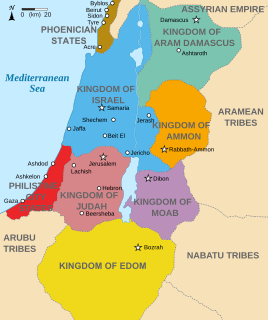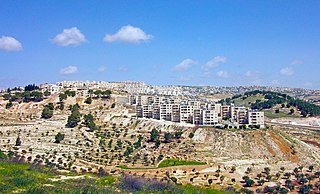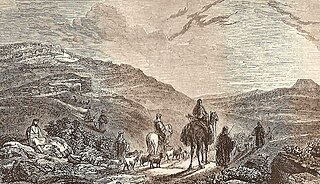Related Research Articles

Bethlehem is a city in the central West Bank, Palestine, about 10 km south of Jerusalem. Its population is approximately 25,000, and it is the capital of the Bethlehem Governorate of the State of Palestine. The economy is primarily tourist-driven, peaking during the Christmas season, when Christians make pilgrimage to the Church of the Nativity. The important holy site of Rachel's Tomb is at the northern entrance of Bethlehem, though not freely accessible to the city's own inhabitants and in general Palestinians living in the occupied West Bank due to the Israeli West Bank barrier.

Bethel was an ancient Israelite sanctuary frequently mentioned in the Hebrew Bible.

Moab is the name of an ancient Levantine kingdom whose territory is today located in the modern state of Jordan. The land is mountainous and lies alongside much of the eastern shore of the Dead Sea. The existence of the Kingdom of Moab is attested to by numerous archaeological findings, most notably the Mesha Stele, which describes the Moabite victory over an unnamed son of King Omri of Israel, an episode also noted in 2 Kings 3. The Moabite capital was Dibon. According to the Hebrew Bible, Moab was often in conflict with its Israelite neighbours to the west.

Jesse or Yishai, is a figure described in the Bible as the father of David, who became the king of the Israelites. His son David is sometimes called simply "Son of Jesse". The role as both father of King David and ancestor of Jesus has been used in various depictions in art, e.g. as the Tree of Jesse or in hymns like "Lo, how a rose e'er blooming."
Umm el-Marra,, east of modern Aleppo in the Jabbul Plain of northern Syria, was one of the ancient Near East's oldest cities, located on a crossroads of two trade routes northwest of Ebla, in a landscape that was much more fertile than it is today. Possibly this is the city of Tuba mentioned in Egyptian inscriptions listing cities that were defeated or destroyed in the Pharaoh Thutmose III's north Syrian campaign. The city of Tuba is also mentioned in epigraphic remains from Ebla, Mari, and Alalakh.

The Star of Bethlehem, or Christmas Star, appears in the nativity story of the Gospel of Matthew chapter 2 where "wise men from the East" (Magi) are inspired by the star to travel to Jerusalem. There, they meet King Herod of Judea, and ask him:
Where is He who has been born King of the Jews? For we have seen His star in the East and have come to worship Him.

Kadesh or Qadesh or Cades is a place-name that occurs several times in the Hebrew Bible, describing a site or sites located south of, or at the southern border of, Canaan and the Kingdom of Judah in the kingdom of Israel. Many modern academics hold that it was a single site, located at the modern Tel el-Qudeirat, while some academics and rabbinical authorities hold that there were two locations named Kadesh. A related term, either synonymous with Kadesh or referring to one of the two sites, is KadeshBarnea. Various etymologies for Barnea have been proposed, including 'desert of wanderings,' but none have produced widespread agreement.

Har Homa, officially Homat Shmuel, is an Israeli settlement in southern East Jerusalem, near Beit Sahour. The settlement is also referred to as "Jabal Abu Ghneim" which is the Arabic name of the hill. One purpose given for the decision approving of its establishment was to obstruct the growth of the nearby Palestinian city of Bethlehem.

Umm Tuba is a Palestinian Arab neighborhood in East Jerusalem part of Sur Baher; it is northeast of Har Homa and Bethlehem, and southeast of Kibbutz Ramat Rachel. It has a population of 4,000. After the 1967 Six-Day War, Umm Tuba was incorporated into the municipal district of Jerusalem.
Ramah was, according to the Hebrew Bible, a city in ancient Israel in the land allocated to the tribe of Benjamin. It was located near Gibeon and Mizpah to the West, Gibeah to the South, and Geba to the East. It has been identified with modern Er-Ram, about 8 kilometres (5.0 mi) north of Jerusalem.

Teqoa is a Palestinian town in the Bethlehem Governorate, located 12 km southeast of Bethlehem in the West Bank. The town is built adjacent to the biblical site of Tekoa (Thecoe), now Khirbet Tuqu’, from which it takes its name. Today's town includes three other localities: Khirbet Ad Deir, Al Halkoom, and Khirbet Teqoa. According to the Palestinian Central Bureau of Statistics (PCBS), Teqoa had a population of 8,881 in 2007.

Uzair is a figure who is mentioned in the Quran, Surah At-Tawba, verse 9:30, which states that he was revered by the Jews as "the son of God". Uzair is most often identified with the biblical Ezra. Modern historians have described the reference as "enigmatic", since such views have not been found in Jewish sources. Islamic scholars have interpreted the Quranic reference in different ways, with some explaining that it alluded to a specific group of Jews.

Ein Rogel, also known as Well of Job, was a spring on the outskirts of Jerusalem mentioned in the Hebrew Bible as the hiding-place of David's spies, Jonathan and Ahimaaz, during Absalom's uprising against the rule of King David. It may also have been a sacred place in pre-Israelite times.

The annunciation to the shepherds is an episode in the Nativity of Jesus described in the Bible in Luke 2, in which angels tell a group of shepherds about the birth of Jesus. It is a common subject of Christian art and of Christmas carols.
Beeroth was a Biblical city seven miles northwest of Jerusalem. The city was an ancient Hivite settlement, and is mentioned in Joshua 9:17, 18:25, 2 Samuel 4:2-3, Ezra 2:25 and Nehemiah 7:29. Another town named Beeroth is mentioned in Deuteronomy 10:6.

Ruth 1 is the first chapter of the Book of Ruth in the Hebrew Bible or the Old Testament of the Christian Bible, part of the Ketuvim ("Writings"). This chapter contains the story of how Elimelech, Ruth's father-in-law, driven by famine, moved into Moab, and died there ; Naomi returning home, Ruth accompanies her ; They came to Bethlehem.
References
- ↑ NIV: 2 Samuel 23:28-29
- ↑ NIV: Ezra 2:22
- ↑ The Illustrated Bible Dictionary page 1077 ISBN 978-0-85110-628-1
- ↑ Israel Antiquities Authority